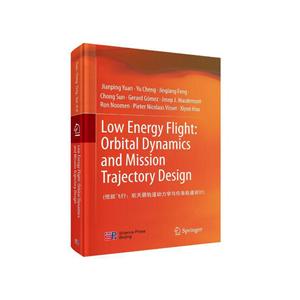掃一掃
關注中圖網
官方微博
本類五星書更多>
-
>
公路車寶典(ZINN的公路車維修與保養秘籍)
-
>
晶體管電路設計(下)
-
>
基于個性化設計策略的智能交通系統關鍵技術
-
>
花樣百出:貴州少數民族圖案填色
-
>
山東教育出版社有限公司技術轉移與技術創新歷史叢書中國高等技術教育的蘇化(1949—1961)以北京地區為中心
-
>
鐵路機車概要.交流傳動內燃.電力機車
-
>
利維坦的道德困境:早期現代政治哲學的問題與脈絡
低能飛行:航天器軌道動力學與任務軌道設計(英文版) 版權信息
- ISBN:9787030619778
- 條形碼:9787030619778 ; 978-7-03-061977-8
- 裝幀:圓脊精裝
- 冊數:暫無
- 重量:暫無
- 所屬分類:>
低能飛行:航天器軌道動力學與任務軌道設計(英文版) 本書特色
本書在現代航天動力學的框架下,研究了低能飛行中的軌道動力學問題和任務軌道(轉移或者目標軌道)設計問題。旨在用新的方法解決傳統的問題,或者對若干亟待解決的新問題展開探索研究,涵蓋了以下主題:利用虛擬引力場法進行小推力轉移軌道設計,三體系統中基于不變流形的轉移問題,天基人工磁場下的編隊飛行,以及強不規則小行星附近的軌道力學。
低能飛行:航天器軌道動力學與任務軌道設計(英文版) 內容簡介
本書在現代航天動力學的框架下,研究了低能飛行中的軌道動力學問題和任務軌道(轉移或者目標軌道)設計問題。旨在用新的方法解決傳統的問題,或者對若干亟待解決的新問題展開探索研究,涵蓋了以下主題:利用虛擬引力場法進行小推力轉移軌道設計,三體系統中基于不變流形的轉移問題,天基人工磁場下的編隊飛行,以及強不規則小行星附近的軌道力學。
低能飛行:航天器軌道動力學與任務軌道設計(英文版) 目錄
Contents
Preface
Chapter 1 Introduction 1
1.1 Low-Thrust Propulsion 3
1.2 Transfer in the Earth-Moon System 4
1.3 Orbital Dynamics Around Irregular Bodies 4
Chapter 2 Continuous Low Thrust Trajectory Design and Optimization 6
2.1 The Virtual Gravity Field Method 6
2.1.1 Introduction[1-25] 6
2.1.2 The Definition of Virtual Central Gravitational Field 7
2.2 Trajectory Design Using the VCGF Method 9
2.2.1 Rendezvous Trajectory Design Using VCGF Method 9
2.2.2 Orbit Interception Trajectory Design Using VCGF Method 14
2.2.3 Mission Applications 15
2.2.4 Conclusion Remarks 24
2.3 Orbital Rendezvous Between Close Near Earth Asteroids Considering the Third Body Perturbation 25
2.3.1 Introduction 25
2.3.2 The Variation of Orbital Elements Caused by the Earth Gravitational Perturbation 27
2.3.3 Orbital Rendezvous Considering the Third Body Perturbation 30
2.3.4 Minimal Fuel Consumption Optimization Using Hybrid Systems 34
2.3.5 Simulation Analysis 36
2.3.6 Conclusions 41
References 42
Chapter 3 Transfer Between Libration Point Orbits and Lunar Orbits in Earth-Moon System 44
3.1 Introduction[1-23] 44
3.2 The Dynamic Model 46
3.2.1 Equations of Motion 46
3.2.2 Change of Coordinates Between the Synodic CR3BP and the Moon-Centred Sidereal Frames 47
3.3 Computation of a Transfer from LPO to a Circular Lunar Orbit 50
3.3.1 Computation of the Transfer Manoeuvre to a Keplerian Ellipse with a Fixed Inclination i 52
3.3.2 Computation of the Departure Manoeuvre: First Approximation 53
3.3.3 Refinement of the Departure Manoeuvre and Determination of P2 55
3.3.4 Computation of the Insertion Manoeuvre at P2 57
3.4 Numerical Results 58
3.4.1 Departing Halo Orbits and Their Invariant Manifolds 58
3.4.2 Selection of the Inclination i1 60
3.4.3 Role of the Angles Between the Arrival and Departure Velocities at P1 and P2 62
3.4.4 The Role of the Orbit on the Unstable Manifold with 64
3.4.5 Varying P1 Along the Manifold Leg 66
3.4.6 Setting P1 at the First Apolune 69
3.4.7 Changing the Sizes of the Departing and the Target Orbits 69
3.5 Conclusions 72
References 73
Chapter 4 Lorentz Force Formation Flying in the Earth-Moon System 76
4.1 Introduction[1-38] 77
4.2 Analysis of the Relative Dynamics of a Charged Spacecraft Moving Under the Influence of a Magnetic Field 78
4.2.1 Modelling Equations and Symmetries 78
4.2.2 Equations of Motion in the Normal, Radial and Tangential Cases 81
4.2.3 Symmetries 82
4.2.4 Equilibrium Points 83
4.2.5 Stability of the Equilibrium Points 85
4.2.6 Zero Velocity Surfaces 89
4.3 Periodic and Quasi-periodic Orbits Emanating from Equilibria 93
4.3.1 Computation of Periodic Orbits Around the Equilibrium Points 93
4.3.2 Computation of 2D Invariant Tori 99
4.3.3 Numerical Results on Periodic and Quasi-periodic Orbits 107
4.3.4 The Normal Case 107
4.3.5 The Radial Case 120
4.3.6 The Tangential Case 125
4.4 Formation Flying Configuration Design 127
4.4.1 Formation Flying Configuration Using Equilibrium Points 127
4.4.2 Formation Flying Configuration Using Periodic Orbits 127
4.5 Conclusions 130
References 121
Chapter 5 1∶1 Ground-Track Resonance in a 4th Degree and Order Gravitational Field 134
5.1 Introduction[1-18] 135
5.2 Dynamical Model 136
5.2.1 Hamiltonian of the System 136
5.2.2 1∶1 Resonance 137
5.3 Primary Resonance 139
5.3.1 EPs and Resonance Width 139
5.3.2 Numerical Results 139
5.4 Secondary Resonance 144
5.4.1 The Location and Width of Hreson2 145
5.4.2 1996 HW1 146
5.4.3 Vesta 151
5.4.4 Betulia 155
5.5 The Maximal Lyapunov Characteristic Exponent of Chaotic Orbits 158
5.6 Conclusions 160
References 162
Chapter 6 Orbital Dynamics in the Vicinity of Contact Binary Asteroid Systems 164
6.1 Summary 164
6.2 Numerical Analysis of Orbital Motion Around Contact Binary Asteroid System 166
6.2.1 Introduction[1-55] 166
6.2.2 Dynamical Model 168
6.2.3 Contact Binary System 1996 HW1 171
6.2.4 Orbital Motion Around the System 181
6.2.5 Conclusions 187
6.3 Orbital Motion in the Vicinity of the Non-collinear Equilibrium Points 188
6.3.1 Introduction 188
6.3.2 Dynamical Model 190
6.3.3 Non-collinear EPs and Their Stability 192
6.3.4 Motion Around the Stable Non-collinear EPs 195
6.3.5 Motion Around the Unstable Non-collinear EPs 201
6.3.6 Conclusions 207
References 208
Appendix A The Primary Zonal and Tesseral Terms Contributing to the 1∶1 Resonance 212
Appendix B The Un-normalized Spherical Harmonic Coefficients to Degree and Order 4 214
References 215
Appendix C The Location of EPs and Resonance Width 216
Appendix D The Second Derivatives of the Potential at the Eps Located at (x0, y0, 0) 218
Appendix E The First and S
展開全部
書友推薦
- >
巴金-再思錄
- >
莉莉和章魚
- >
煙與鏡
- >
經典常談
- >
我從未如此眷戀人間
- >
山海經
- >
月亮與六便士
- >
新文學天穹兩巨星--魯迅與胡適/紅燭學術叢書(紅燭學術叢書)
本類暢銷
















